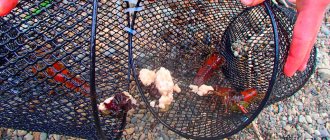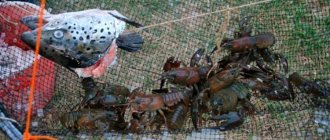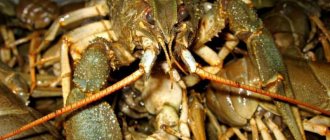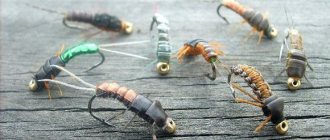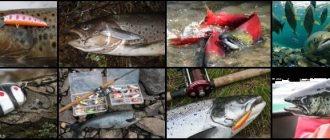Open type traps
These traps are based on the principle of operation of lifts. They are attached to a long, strong pole and taken out of the water vertically. You can fish with them both from the shore and from piers or bridges.
Simple screen
The simplest open type traps are screens. They are a ring of metal wire covered with mesh. Three or four cords of the same length go up from the ring, which are tied together.
Then the main cord is tied to their attachment point, which goes to the handle of the trap.
The bait is attached to the middle of the net in a specially sewn mesh pocket or a woman's stocking, and then the bait is lowered into the water. Sensing the bait, the crayfish crawl towards it and concentrate in the center of the trap. This type of clamshell should be checked every 20-30 minutes. The rise from the water must be done energetically, but evenly, so that the crayfish that look at the “light” do not have time to run away.
It should be noted that the screen can be made not only round, but also square, in the manner of a little fish for catching verkhovka. In this case, the laces can be replaced with knitting needles located at the corners of the structure.
Double open trap
A more convenient catcher for catching crayfish consists of two hoops. The larger one, covered with mesh, forms the bottom of the structure. The smaller circle is connected to the bottom by a vertical mesh, so that a trimmed mesh cone is created.
This crayfish catcher is installed on the bottom so that the upper small hoop seems to hang in the water. This prevents the cancer caught inside the trap from escaping from it.
The use of such a trap makes it possible to check it less often than a simple screen; you can return to the trap no earlier than 4-6 hours.
Inkwell
You don’t have to check an open “inkwell” type rack for even longer. In appearance, it resembles a metal fish tank without a lid. Imagine the design described in the previous chapter, where inside a smaller hoop in the same plane as it, there is another one, and the gap between them is covered with a mesh.
The cancer will be able to get out of this structure only when it is filled to capacity with its fellow tribesmen. Such crayfish traps can be safely left for a day or more.
Features of using crayfish traps for catching crayfish
Content
Crayfish fishing is effective only in clean reservoirs; this is true for any fishing method. In turbid waters, catching crayfish is an extremely difficult task. It is mainly caught on rivers and lakes with standing water or with a slight current.
Important! We recommend installing crayfish traps in rocky places that crayfish loves. Here it is easier for prey to find a secluded place of protection from predators.
The crayfish trap is an interesting device; the crayfish enters it on its own in order to profit from prey, and sometimes simply to hide from danger. Once inside the mesh, the crayfish are unable to get out, since the entrance only works in one direction.
The crayfish is an interesting device for catching crayfish.
There is a lot of confusion in the fishing world as to whether catching crayfish with crayfish is legal. There is a basic rule here – a limit on the number of devices per person. The limit is set by the local fisheries authority. Depending on the region, this limit ranges from three to ten devices per person. Fishing with crayfish is illegal if their number exceeds the established norm.
When choosing which crayfish trap is best to use for catching crayfish, it is important to pay attention to:
- product material. The design is based on either a polyethylene line or a mesh made of nylon thread. For adult, large crayfish, it is preferable to use a polyethylene crayfish trap. Nylon options perform better when catching young animals with a soft shell, as it will not harm the prey. Both types of material are resistant to claws and are used both in fishing from the shore and from a boat;
- country of origin. Domestic gear is much higher quality than Chinese models, there are still good options for imported devices, although their price is very high;
- shape of the structure. The choice of form is most influenced by the amount of expected catch. In a round trap with a diameter of 40 cm in most reservoirs it is possible to catch about 10 crustaceans. Up to 80 crayfish can be placed in a long tackle with a diameter of 50 cm, located in a place where there is a lot of prey;
- fishing period. There are long designs designed for long outings. These structures are larger than their analogues and can accommodate more living creatures. Round designs are useful for short-term crayfish hunting.
Read more
What kind of bait does carp like? Recipes and cooking
Before purchasing a trap, you must carefully inspect it for various defects. If the material is old, fragile, rusty, has dents, etc., it is better to refuse the purchase. If you take a container with a defect, there is a risk of losing all your catch and gear during the first outing.
The amount of expected catch affects the choice of shell shape
There are also specific forms of designs; in our latitudes, crayfish are often caught using accordion crayfish traps; they are less spacious, but often show better results than their classic counterparts. Another interesting option is to catch crayfish with an umbrella crayfish; it creates a kind of shelter where the prey swims with pleasure to hide from predators. Catchability is ensured by numerous entrances inside, located on all sides.
Closed traps
Closed traps differ for the better in several ways:
- crayfish from them practically do not scatter;
- their large area allows them to attract more prey;
- they can not be removed from the water for a long time.
Long multi-entry traps
Such crayfish shells are most often made square in cross-section, but they can also be round or rectangular. They range in length from three to fifteen meters with numerous entrances located along the axis of the device.
The procedure for installing a long multi-entry clamshell is as follows:
- First, such a trap is stretched on the shore.
- At the ends it is secured to the ground with pins.
- Place bait through the entrances.
- Holding the ends together, they carry it stretched out into the water.
- The ends are reinforced at the bottom with pins or loaded with stones.
Umbrellas
This polygonal structure is in the form of a metal frame covered with mesh. At the base there can be a figure from a square to an octagon with the corresponding number of inputs.
Such a structure can be carried into the water by hand or lowered on a long pole. Of the closed type traps, this gear is the most compact.
Vershi
A top-type trap is also suitable for catching crayfish. It is a mesh-covered cylinder made of metal rings, which has two end entrances. When folded, this design takes up virtually no space.
This crayfish catcher is installed by simply throwing it into the water in the right place. An elastic spring band located inside the trap prevents it from folding.
Catching crayfish from a boat using a crayfish trap
There are no special secrets for catching crayfish on crayfish traps, but it is important to adhere to some rules. Although optional, a desirable fishing device is a boat.
How to fish from a boat:
- We deliver the trap not far from the undeveloped shore; it is better to look for a place with a cliff.
- We lower the device carefully so that it does not get tangled in reeds and algae.
- If there is a tree or other strong element nearby, attach the rope to it. In the absence of trees and bushes, we tie a stick or foam plastic to the thread to mark the fishing spot. We separately tie a thread behind them and fasten it on the shore.
- We install the following device. When lowering several traps, we maintain a distance of 10-20 m between them.
- We check the crayfish trap no earlier than after 3 hours.
Read more
How and what to catch bleak in the spring?
A boat is a desirable device for catching crayfish using a crayfish trap.
Lures
The same baits are used for all shell designs. Crayfish prefer fresh fish, but they also use:
- dried or burnt meat;
- white bread with dill or garlic;
- offal of animals or poultry.
It has been noticed that, contrary to the popular belief that crayfish feed on carrion, fresh food, especially cut fish, attracts them much better.
Crayfish prefer wheat bread rather than rye bread.
Garlic, in addition to being mixed with bread, is often rubbed onto the metal hoops of crayfish shells.
A very important event is to secure the baits inside the crayfish traps. To prevent bread from crumbling into pieces or particles of fish or meat from floating away, deal with them as follows:
- Wrapped in rare fabric. It could be: gauze, tulle, nylon.
- Attach the cloth with bait in the center of the trap.
- Anti-floating traps are loaded. To do this, you need to place a stone or a piece of metal, or even just a bag of sand, in the center of the shell.
How to install shells?
The location of the crayfish depends on what type of shell is used. Depending on the shape of the gear, the installation method may differ significantly:
- Cone. It is advisable to install from a boat. Rakolov swims to the desired place and, holding the top foam plastic, gradually lowers the crayfish into the water. If this is not possible, then the stick is threaded through the last bunch of ropes and installed near the shore. But still, it is better to put tackle of this shape from a boat.
- Ball. A rope is tied to the crayfish and simply thrown into the water so that the bait does not fall out, without any sudden movements. In this case, there is no significant difference in how the installation will be carried out from the shore or from a boat.
- Rectangular. With this form of gear, it is best to install from the shore. It is placed where there is a smooth descent of the bottom and there are no sharp cliffs of the shore. The principle of casting is the same as for a ball, but you just need to be more careful so that there is no confusion.
We recommend reading: How to choose the best spinning rod for twitching, rating of models
It is better to place other types of crayfish shells of non-standard shape from a boat, since they need to be lowered evenly.
How to catch
Before you start catching crayfish, you need to properly equip the crayfish trap and install it in the pond. Small traps are usually used several at a time, usually up to five per hunter.
The best time to catch crayfish is autumn, the second half of September and all of October. It is at this time that favorable factors for successful fishing come together:
- water transparency allows for better control of the process;
- fattening makes crayfish meat the most delicious;
- bans on catching crayfish are lifted;
- as the water cooled, the molting period ended;
- Daylight hours are shortening, which means fishing time is lengthening.
As for the time of day, crayfish can be most successfully caught at dusk and at night. Having spent the whole day in a hole, the crayfish comes out to feed in the evening and looks for food until dawn.
Where to fish
Crayfish are found in almost all fresh water bodies, where there is sufficiently fresh, preferably running, water and the acidity level is neutral or alkaline. In the reservoir itself, you should look for these animals under steep banks, in snags, or near accumulations of higher aquatic plants, such as reeds, cattails or reeds.
The depth of habitat of crayfish ranges from fifty centimeters to three meters. The bottom in this place is preferably clayey or rocky, although it is best when there is a border of stones and clay near the steep bank.
The muddy and sandy bottom prevents the creation of crayfish burrows, and the silt also makes it difficult for crayfish to move along the bottom.
Areas of clay bottom with sparse grassy cover located in the coastal zone of the reservoir will also be good places. Such clearings are readily visited by crayfish for feeding.
Where and when to catch crayfish using a crayfish trap?
Crayfish are extremely demanding inhabitants; they prefer to live in exceptionally clean and fresh water. The color of the water is not of fundamental importance, but the presence of a high concentration of oxygen and a small amount of acids is important. Usually found in rivers, but also found in other bodies of water.
Many crustaceans prefer to live on a hard bottom made of stones. It is important for them to have places at the bottom where they can easily hide in times of danger. Snags, stones, etc. serve as original shelters. If the reservoir is shallow and has a sandy bottom, crayfish will not settle here due to the lack of places where they can hide. If there are steep banks, there is a high probability of finding crayfish; they like to build holes and hide in them.
The timing of catching crayfish on crayfish traps is important, since not in all seasons it will be possible to get a catch even with bait. The activity of these river inhabitants directly depends on the water temperature. If there is warm weather in the summer, you can get a good catch in June and May. In cold regions or during a long winter, the molting of crayfish is delayed; catching them can only begin in mid-July or later.
Important! Active fishing continues until September, then the taste quality deteriorates greatly, and the amount of catch is significantly reduced. Due to the increased strength of the shell, the demand for crayfish decreases. But in the autumn, catching crayfish by hand becomes easier; with the appearance of the first frosts closer to night, the crayfish run aground. Autumn fishing continues until freeze-up.
Crayfish live in clean, fresh water.
In the summer, it is better to catch crustaceans at night, when they leave their shelters in search of food. The greatest activity is observed from 22:00 to 3:00. Sometimes crayfish tend to go hunting before dawn.
Read more
Which fishing line to choose for a float rod?

